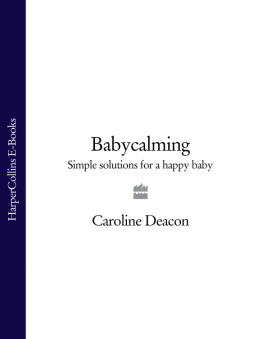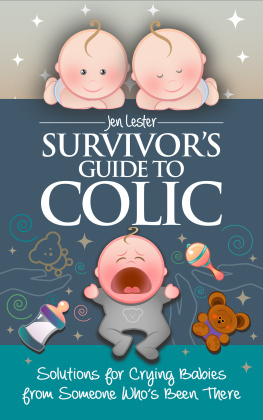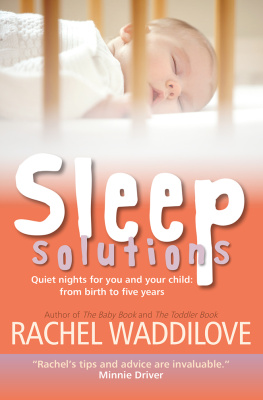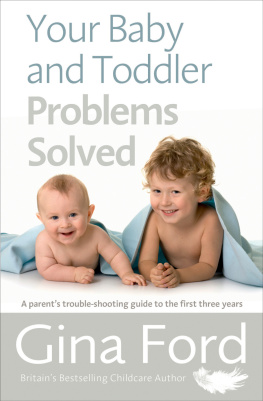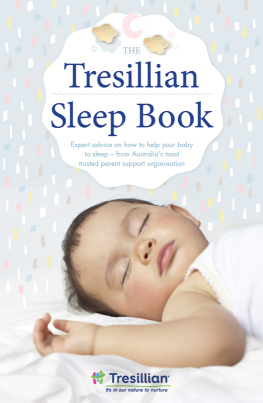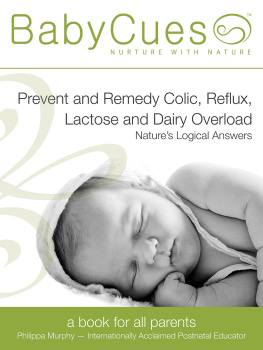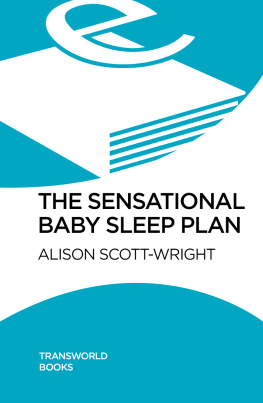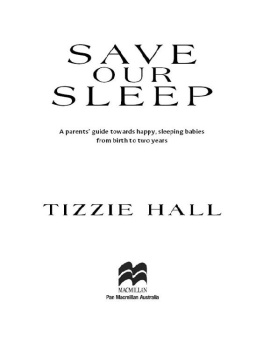
Thorsons
An Imprint of HarperCollinsPublishers
1 London Bridge Street
London SE1 9GF
www.harpercollins.co.uk
Thorsons is a trademark of
HarperCollinsPublishers Ltd
First published in collaboration
with National Childbirth Trust Publishing 2004
NCT Publishing 2004
Caroline Deacon asserts the moral right to be identified as the author of this work
Extracts from Dream Babies by Christina Hardyment (Jonathan Cape, 1983,) are published with kind permission of the author 1983 by Christina Hardyment
A catalogue record for this book
is available from the British Library
All rights reserved under International and Pan-American Copyright Conventions. By payment of the required fees, you have been granted the nonexclusive, nontransferable right to access and read the text of this e-book onscreen. No part of this text may be reproduced, transmitted, downloaded, decompiled, reverse engineered, or stored in or introduced into any information storage and retrieval system, in any form or by any means, whether electronic or mechanical, now known or hereinafter invented, without the express written permission of HarperCollins e-books.
HarperCollinsPublishers has made every reasonable effort to ensure that any picture content and written content in this ebook has been included or removed in accordance with the contractual and technological constraints in operation at the time of publication.
Source ISBN: 9780007159024
Ebook Edition JUNE 2016 ISBN: 9780007380022
Version: 2016-06-29
After all the anticipation during pregnancy, when your baby finally arrives, no matter how organized you are, life will feel pretty chaotic amidst the excitement and wonder. New parents in particular are thrown straight in at the deep-end after all, your baby doesnt come with a handy manual and the sense of responsibility can be overwhelming.
What You Need
Like most people, you are probably used to running your life with one eye on the clock and the other on the task in hand: you have a routine and normally expect to do certain things in a certain order throughout the day. Because of this, it is natural to hope that your baby will fall into a routine that will complement yours and enable you to plan and manage your day-to-day life.
At the same time, you also hope that your baby will be happy, feed easily and sleep well. If he cries, you would like what he needs to be obvious, so that you can know how to respond. However, many babies do not appear to behave like this: they cry seemingly without reason, they sleep in fits and starts or they want to feed all the time. They dont seem to have an internal clock and they show no interest in the clock on the wall!
What Your Baby Needs
Your baby spent his first nine months being held, rocked and moved around in the womb. He was in constant contact with his mum and could hear her heartbeat, her voice, feel the warmth of her body and the sensation of being tightly held. He expected things to continue like this after birth: being in constant contact with another human being, feeling warm, snug and secure. If he thinks has been abandoned, he cries, a response that has evolved over millions of years to make sure a responsible adult picks him up and keeps him safe. If he is hungry, uncomfortable, tired or bored he will cry.
How to Help Your Baby
A psychologist called Maslow pointed out that in order for human beings to be fulfilled, reach their potential and enjoy life reach self-actualization is how he put it they need to have their basic needs met. You cant sit and concentrate on a book or film if you are hungry, thirsty or need the toilet. Great philosophy or art will pass you by if you are homeless and worried about your safety.
Babies are like this, too if their basic needs are not met, they cannot be happy and secure, and although there are lots of similarities between adult needs and baby needs, there are differences, too.
We all need to have enough to eat and drink, and we need to have times to rest and sleep. We all need to feel safe for grown-ups this might mean that the rent or mortgage is paid or that our homes are secure and we can sleep soundly at night but for your baby, feelings about safety are a little different. Babies expect adults to fend off danger, so for your baby, safety is about human companionship. If there is a reliable grown-up nearby, then he can relax.
For your baby to feel happy and contented, you need to fulfil his three basic needs:
Contact
Food
Sleep
Over time, the way you meet these needs, and the balance between them, changes. This is perhaps one of the most difficult things to grasp in parenting the rules change all the time, and what worked today will no longer be appropriate tomorrow. Where we often go wrong is in thinking that methods stay constant.
For instance, feeding a baby whenever he is hungry, day or night, is perfectly appropriate at two weeks, but is no longer appropriate at two years. Sharing your bedroom, if not your bed, with a baby of five weeks is safe and easy; sharing your bed with a five-year-old is less easy; sharing your bed with a fifteen-year-old would certainly be odd! Responding the instant your baby cries when he is little is appropriate; responding to a toddler who is yelling for sweets is not kind in the long run.
Every healthy baby wants to communicate, will make demands and will make his presence felt. Initially, the only way he knows how to get your attention is by crying. In general, if you understand and work within his needs, he will not need to cry for prolonged periods and you and he will enjoy plenty of positive and happy times together.
This does not mean endless self-sacrifice on your behalf: normally, your needs and your babys needs will not fundamentally conflict, because nature has designed a system that works in harmony with you both.
What This Book Can Do for You
This book is fundamentally different from the many other parenting books on the shelves. Some books cast you loose, tell you to trust your instincts and leave you to get on with it. If anything, they hope that if you respond to your baby all the time without question, he will eventually just evolve into the kind of child that you would like him to be. Most parents need more reassurance and guidance than that.
Other books and this is a more popular approach at the moment impose on your baby a rigid schedule from the day he is born. However, unless this particular schedule happens to suit you and your baby, you are probably both going to be unhappy with it. If it does work for you, the chances are that this is the schedule or routine you would both have arrived at anyway!
Then there is a third way, a middle way, which is to understand your babys needs, respond to them appropriately, and to introduce the routines and boundaries your child wants but at the right times and in a way that does not fundamentally conflict with your own needs. Babycalming follows this third way and shows you what is appropriate and when. It is a three-step plan based on your babys three basic needs for contact, food and sleep, and it will also help you to devise and settle into a routine that is right for you both.
It is a combination of tried-and-tested methods from my experience as an NCT (National Childbirth Trust) breastfeeding counsellor and mother of three, and research-based evidence.
Throughout the book you will find quotations from different experts, philosophers and public figures regarding children and childcare over the last couple of centuries. They are quoted at the beginning of each chapter, then at the end you will find out when it was said. You will see that some opinions on childcare havent changed at all, whereas others will seem completely inappropriate. They are there to remind you that opinions on childcare change all the time, and that as a parent you can only do what you think is best for your baby at the present time according to all the information and advice you have at that moment.
Next page
